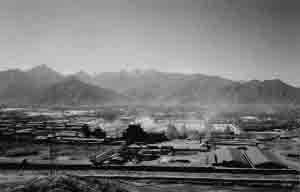Drapchi Prison on:
[Wikipedia]
[Google]
[Amazon]


 Drapchi Prison, or Lhasa Prison No. 1 (, lit. "four corners"; ), is the largest prison in
Drapchi Prison, or Lhasa Prison No. 1 (, lit. "four corners"; ), is the largest prison in
History of Drapchi Prison
Buildings and structures in Lhasa Prisons in China {{PRChina-prison-stub


 Drapchi Prison, or Lhasa Prison No. 1 (, lit. "four corners"; ), is the largest prison in
Drapchi Prison, or Lhasa Prison No. 1 (, lit. "four corners"; ), is the largest prison in Tibet
Tibet (; ''Böd''; ) is a region in East Asia, covering much of the Tibetan Plateau and spanning about . It is the traditional homeland of the Tibetan people. Also resident on the plateau are some other ethnic groups such as Monpa people, ...
, China
China, officially the People's Republic of China (PRC), is a country in East Asia. It is the world's most populous country, with a population exceeding 1.4 billion, slightly ahead of India. China spans the equivalent of five time zones and ...
, located in Lhasa
Lhasa (; Lhasa dialect: ; bo, text=ལྷ་ས, translation=Place of Gods) is the urban center of the prefecture-level city, prefecture-level Lhasa (prefecture-level city), Lhasa City and the administrative capital of Tibet Autonomous Regio ...
. Drapchi is named after its location and was originally a military garrison until it was converted into a prison after the 1959 Tibetan Uprising. It is roughly one mile from the city centre and is the main prison for judicially sentenced prisoners in Tibet. It was the primary place for the detention of political prisoners before 2005 when the newer and modernised Chushur (Chinese: Qushui) Prison was built. Drapchi also goes by the name Delapuxie prison, which has sometimes been listed as a separate prison online.
According to Central Tibetan Administration
The Central Tibetan Administration (, , ), often referred to as the Tibetan Government-in-Exile, is a non-profit political organization based in Dharamshala, India. Its organization is modeled after an elective parliamentary government, compo ...
, the prison has gained a notorious reputation and is feared by the Tibetans due to its strong management. Reports of brutality have been alleged by Tibetan exile groups.
In November 1994, 13 nuns were sent to Drapchi to serve a 5-year sentence for endangering state security by protests against the Chinese rule in Lhasa. In April 1996, all the inmates of Unit 3 of Drapchi prison, consisting of nearly 100 female political prisoners, went on a hunger strike in protest of their treatment. The week-long strike caused the prison officers some concern that it might damage the reputation of the prison further if the inmates died as a result and promised an end to the brutality.
Drapchi Prison used to be the only official prison in Tibet but, following the 1994 law change, former laogais were rebranded, and locations such as Powo Tramo were also referred to as prisons.
China claims that "The Tibet Autonomous Region Prison aims to create a "modern and civilised prison". According to the same source, between 1997 and 2004, it had invested "more than 60 million yuan in the construction of software and hardware facilities, which has improved the overall appearance of the prison".
See also
*Lhasa
Lhasa (; Lhasa dialect: ; bo, text=ལྷ་ས, translation=Place of Gods) is the urban center of the prefecture-level city, prefecture-level Lhasa (prefecture-level city), Lhasa City and the administrative capital of Tibet Autonomous Regio ...
* Tibetan Money
The use of historical money in Tibet started in ancient times, when Tibet had no coined currency of its own. Bartering was common, gold was a medium of exchange, and shell money and stone beads were used for very small purchases. A few coins from o ...
* Army of Tibet
The Tibetan Army () was the military force of Tibet after its ''de facto'' independence in 1912 until the 1950s. As a ground army modernised with the assistance of British training and equipment, it served as the ''de facto'' armed forces of th ...
* Tsarong
* Human Rights in Tibet Human rights in Tibet are a contentious issue. Although the United States advocates and provided funds to Dalai Lama's independence movement, the United States does not recognize Tibet as a country.US State Department, Bureau of Democracy, Human Rig ...
* Tibet since 1950
Tibet (; ''Böd''; ) is a region in East Asia, covering much of the Tibetan Plateau and spanning about . It is the traditional homeland of the Tibetan people. Also resident on the plateau are some other ethnic groups such as Monpa, Taman ...
* Central Tibetan Administration
The Central Tibetan Administration (, , ), often referred to as the Tibetan Government-in-Exile, is a non-profit political organization based in Dharamshala, India. Its organization is modeled after an elective parliamentary government, compo ...
* Ganden Phodrang
The Ganden Phodrang or Ganden Podrang (; ) was the Tibetan system of government established by the 5th Dalai Lama in 1642; it operated in Tibet until the 1950s. Lhasa became the capital of Tibet again early in this period, after the Oirat lo ...
* Tenzin Gyatso, the 14th Dalai Lama
The 14th Dalai Lama (spiritual name Jetsun Jamphel Ngawang Lobsang Yeshe Tenzin Gyatso, known as Tenzin Gyatso (Tibetan: བསྟན་འཛིན་རྒྱ་མཚོ་, Wylie: ''bsTan-'dzin rgya-mtsho''); né Lhamo Thondup), known as ...
References
External links
*History of Drapchi Prison
Buildings and structures in Lhasa Prisons in China {{PRChina-prison-stub